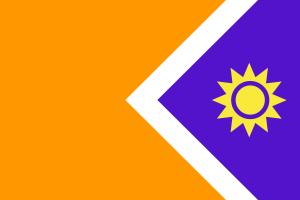Language/Marathi/Grammar/Gender
Hi Marathi learners! 😊
In this lesson, we will learn about Marathi grammar gender. Marathi, like many other languages, has two genders - masculine and feminine. This feature is important to understand the language, its structure, and its culture. In this lesson, we will explore how gender works in Marathi and how you can incorporate it into your Marathi language skills. So, let's get started!
Introduction[edit | edit source]
Gender is a grammatical category used in many languages to distinguish between male and female entities. In most nouns and pronouns, gender is arbitrary and does not necessarily correspond to biological sex. In Marathi, like other Indo-Aryan languages, gender is an important aspect of grammar, as it plays a significant role in sentence structure, verb conjugation, and adjective usage.
To understand gender better, it is important to note that Marathi nouns are classified as masculine and feminine, based on the last letter of the word, and occasionally by way of the entire word itself.
Some common rules that help in identifying the gender of a Marathi noun:
- Nouns that end with "आ" "मा" "ता" "ऊ" "ळ" "ई" "ए" "अ" "इ" "उ" "आ" are usually feminine.
- Nouns that end with "आ" "ऊ" "अ" "इ" "खा" "ळ" "आ" "ती" are usually masculine.
However, there are some exceptions to these rules.
Now that we know the basic rules to identify the gender of Marathi nouns let's move ahead and see how gender impacts sentence structure, conjugation, and adjective usage.
Take some time to dive into these other pages after completing this lesson: Future Tense & Spelling and grammar check.
Gender and its Impact on Sentence Structure[edit | edit source]
Gender has a significant impact on the Marathi language sentence structure. There are often differences in the structure of sentences based on the gender of the subject, object, or pronoun used.
For example:
| English | Marathi (Masculine) | Marathi (Feminine) |
|---|---|---|
| She is drinking water. | ती पाणी पीत आहे. | ती पाणी पीते आहे. |
| He is reading a book. | तो कादंबरी वाचतो. | ती कादंबरी वाचते. |
| They are playing football. | ते फुटबॉल खेळत आहेत. | ती फुटबॉल खेळते आहेत. |
As you may have noticed from the table above, the sentence structure changes based on the gender of the noun used. For instance, "He" is "तो" (to), and "She" is "ती" (ti), which changes the endings of certain verbs. In the third sentence, "They" is "ते" (te) for masculine and "ती" (ti) for feminine sentences.
Gender and its Impact on Verb Conjugation[edit | edit source]
Gender also influences verb conjugation in Marathi. The verb must agree with the subject's gender in number and person, which means that one set of verbs is used for masculine subjects, and another set is used for feminine subjects.
For instance:
- माझा ठीक आहे (mazhA theek ahe; I am fine - for masculine subject)
- माझी ठीक आहे (mazhI theek ahe; I am fine - for feminine subject)
In the above examples, माझा (mazhA) is used for a masculine subject, and माझी (mazhI) is used for a feminine subject.
Gender and its Impact on Adjective Usage[edit | edit source]
Much like verb conjugation, adjectives in Marathi must also agree with the gender of the noun being described, and are used in both feminine and masculine forms.
For instance:
| Marathi | Pronunciation | English |
|---|---|---|
| वाटोळा वळत असला | watolA vaLaT aslA | The ball was round (for masculine noun) |
| वाटी वळती होती | vatI vaLaTee hotI | The ball was round (for feminine noun) |
| तुमचं मोठं आहे | tumachM moTh ahe | your(s) is big (for masculine noun) |
| तुझं मोठं आहे | tuzhM moTh ahe | your(s) is big (for feminine noun) |
In the above examples, the adjectives "वाटोळा" (watolA) and "तुमचं" (tumachM) are used for masculine nouns, and the adjectives "वाटी" (vatI) and "तुझं" (tuzhM) are used for feminine nouns.
Practice Dialogue[edit | edit source]
To better understand gender and its impact on the Marathi language, let's see a dialogue example between two people:
- Person 1: आलं का जुनी फोटो माझ्याकडून? (Aala ka juunee foto mazhyakadun? - Did you receive the old photo from me?)
- Person 2: अरे, आलं नाही. दुसऱ्या फोटोचं बदल करत आहे, नवीन फोटो माझ्या स्मार्टफोनवर आहेत. (are, aala nahee. Dusarya fotO cha badal karat aahe, navIn fotO mazhya smartphone war aaahet. - No, I didn't receive it. I am changing the other photos; new photos are on my smartphone. )
In the above practice dialogue, note the difference in the verb conjugation with the use of feminine and masculine nouns.
Conclusion[edit | edit source]
In conclusion, gender is an essential aspect of the Marathi language. It is used in nouns, verbs, and adjectives, and is important in determining sentence structure, verb conjugation, and adjective usage. Understanding gender in Marathi is crucial for anyone learning the language to communicate when speaking and writing in it. We hope that this lesson has helped you gain a better understanding of Marathi grammar gender.
To further improve your Marathi Grammar, you can also use the Polyglot Club website. Find native speakers and ask them any questions!
➡ If you have any questions, please ask them in the comments section below.
➡ Feel free to edit this wiki page if you think it can be improved. 😎
Sources[edit | edit source]
- Marathi grammar - Wikipedia
- The lexical and discourse functions of grammatical gender in Marathi
- Marathi language - Wikipedia
Excellent job on conquering this lesson! Consider delving into these related pages: Subject Object Verb & 0 to A1 Course.

